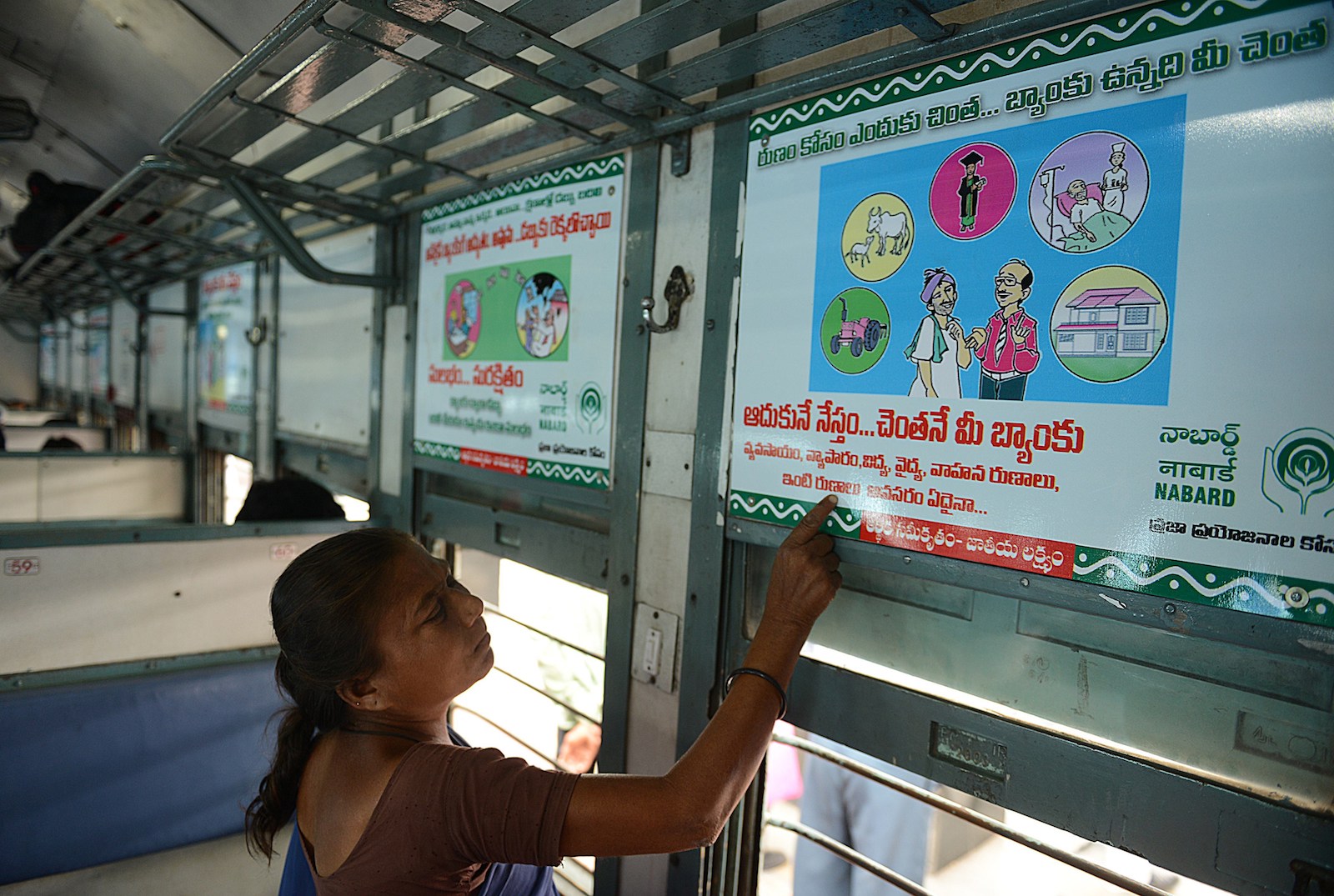Bringing Fun to Financial Literacy in Asia

A train passenger looks at a financial literacy campaign poster inside a train in Hyderabad, India. With many countries in Asia developing at great speeds, the need for financial literacy is paramount.
Photo: Noah Seelam/AFP/Getty Images
Despite being a necessary life skill that has grown in importance in today’s complex world, financial literacy is still often seen as boring. Additionally, on the surface, it may seem that the need for financial literacy is greater in emerging economies, but it is truly a global problem, as only a third of adults worldwide show an understanding of basic financial concepts.
This is not to say that such countries, even emerging ones, are bereft of financial literacy strategies, but oftentimes these strategies are patchy and lack a defined approach in their implementation. In spite of the prevalence of research and strategy design, their practical application has been sorely lacking, therefore consigning financial literacy mostly to the purview of academicians.
So, when looking at Southeast Asia, this problem is indeed stark given that the average financial literacy scores in five Southeast Asian countries (Malaysia, Indonesia, Thailand, Vietnam and Cambodia) is just 12.46 percent.
And this lack of financial literacy can have a direct and significant impact on millions of individuals, leading to negative societal impacts, such as poor borrowing decisions and lack of insurance protection. This is especially true considering that the health care protection gap in Asia’s emerging markets constituted nearly 78 percent of the total $1.8 trillion gap in the Asia-Pacific. A significant factor is that insurance penetration is still low in Asia, especially the penetration of nonlife products, which is below 2 percent of GDP.
Hence, whether it is to keep fresh graduates from overspending on their first paychecks or helping newlyweds choose which mortgage plan is best for them, there is a need to revise the way financial literacy is being taught to all demographics.
Get the Basics Right
A bottom-up approach, paired with a top-down approach when communicating financial literacy, is needed to generate greater impact, especially in Southeast Asia where financial literacy levels need to catch up to the global average. The global average for financial literacy between adults is 33 percent, according to the S&P’s Global Financial Literacy Survey, as compared to the regional average of 12.46 percent.
The value of financial literacy is clear when an individual must make a decision affecting their financial life—from deciding to put coins in a piggy bank to picking out the right mortgage. Businesses and employers in Asia also have an obligation and an opportunity to be leaders in cultivating societal financial literacy. Case in point: How many members of staff of a financial services company truly understand the benefits and risks of its products? When engaging with clients, how many are ensuring that these clients truly understand the fundamentals, let alone the benefits and risks of a financial product (and not just ticking the compliance boxes)? And when an employee faces some financial strife, what is the employer doing to help them understand it and deal with it? In fact, what are they doing to help prevent the strife in the first place?
Strategically, an organization dealing with financial literacy can position itself as a leader—one that understands and empathizes with its employees and clients—thereby announcing that it is integral to its relationships and business. This is even more pertinent for financial services firms where money matters form their core. Instead of simply “advising to sell,” they can and should be “advising to educate” in order to foster deeper engagements and value for both the client and the company. In the Southeast Asian region, Singapore leads efforts in financial literacy. It topped the 2016 Mastercard Financial Literacy Index and is spearheading financial literacy education in schools on a large-scale basis. Just this month, the DBS Bank announced a tie-up with the Institute of Technical Education (ITE) to roll out an enhanced financial literacy program to all ITE first-year students.
Teaching financial literacy cannot take a one-size-fits-all approach that overlooks the diversity of the region.
Think Outside the Box
Boring requires creativity as a solution. While the number of experts offering advice as speakers at seminars, conferences and customer get-togethers is plenty, all too often smartphones will come out and glazed looks will start to appear. And while there is indeed academic depth to financial literacy expertise, there is a lack of true connection between the topic and the audience.
However, over the last few years, there has been development in the use of comics, animation and digital games to try and make financial literacy more engaging and more easily communicable. The good news is that companies across Asia are working to improve financial literacy among people when they are young. For example, Prudential is teaching kids about financial literacy via its Cha-Ching music video series featuring cartoon characters; whereas the AEIOU Financial Comic Strip Challenge by Alliance Bank in Malaysia is doing so through comics. However, the financial literacy education game must step up to be interactive for a wider range of audiences.
By virtue of the aforementioned mediums, such strategies are primarily targeted at kids and youths, which can generate more success during classroom activities. Nevertheless, breadth and depth can be lacking in these approaches and, at some point, those types of engagements end as the audience matures.
An oft-forgotten, but now appreciated, means of dealing with difficult topics is experiential learning; in other words, learning by doing. As kids, we tend to learn how to do things by observing what is being done around us as we evolve our life skills. Hence, experiential gameplay design to address financial literacy is becoming a proven and powerful means to engage and educate everyone, no matter the age, culture, demographics or circumstances. While it is fun, it also has breadth and depth. The ability to simulate real-life experiences (without the actual risk) that can be tailored to any audience can boost the financial literacy required from kids to adults.
As gameplays can evolve as a solution—like money itself—they can be continuously designed and applied for specific circumstances, which then allows for much deeper and longer connections with clients and employees. This, in turn, positively affects the bottom line.
Out of Ivory Towers and into Homes
Financial literacy has been a well-known issue for decades and will continue to be one as money continues to be central in our lives and societies in the time to come. With many countries in Asia developing at great speeds, the need for financial literacy is paramount. The issue must now move from strategy and policy development to producing real action and results that are visible to the layperson.
And to successfully engage all people, no matter their culture or creed, on an important life skill, creative solutions are needed now more than ever.
In Southeast Asia alone, the region is home to 10 countries that have their respective idiosyncrasies in language, culture, income levels and purchasing habits—all of which have significant impacts on how people manage their finances. Teaching financial literacy cannot take a one-size-fits-all approach that overlooks the diversity of the region. It first requires a deep understanding of its markets and how people are using their money; only then can the best engagement strategies be created to generate the biggest impact.






